Stoloteuthis leucoptera
Michael Vecchione and Richard E. YoungIntroduction
Stoloteuthis leucoptera, the type and the best known species of the genus, is very common throughout the year in the Gulf of Maine, U.S.A., at depths of 175 to 340 m. Only a few specimens have been taken on the outer shelf and slope south of Cape Cod, although it is found as far south as the Straits of Florida. It has also been reported from the Eastern Atlantic. This species, which reaches 25 mm ML, can be distinguished easily from all other neritic sepiolids in the western North Atlantic by the large ventral shield of the mantle characteristic of all members of the Heteroteuthinae. Note the dramatic blue fringe to the shield in the title photograph and the silvery band of tissue around the mantle.
Brief diagnosis:
A Stoloteuthis with...
- Narrow head-mantle fusion.
- glandular structures on dorsal and ventral borders of arms I in males.
Characteristics
- Arms (from Villanueva and Sánchez, 1993)
- Aboral keel well developed on arms III.
- Arms with 2 series of globular suckers except for 3-4 series at tips of arms IV in males.
- Males:
- Arms II with 1 or 2 (rarely 3) enlarged suckers at location of suckers 10-12.
- All suckers on arms II and III (at least) enlarged relative to females.
- Arms I with "cushion-like lateral membranes" on basal 2/3rds of arms.
- "Transverse [glandular] bundles of white finger-shaped structures 1.52 mm long by 0.38 mm wide adjacent to these membranes on arms I on both dorsal and ventral sides."
 Click on an image to view larger version & data in a new window
Click on an image to view larger version & data in a new window
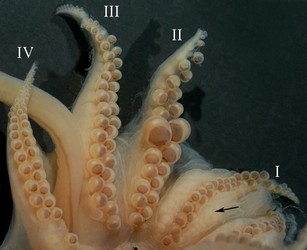
Figure. Oral view of the brachial crown of S. leucoptera. Left - Male, 15.6 mm ML, eastern South Atlantic off Nambia, Africa. Drawing from Villanueva and Sánchez (1993). Right - Male, 22 mm ML, preserved, western North Atlantic off USA. Photograph by R. Young.
- Females:
- Arms not modified in females.
 Click on an image to view larger version & data in a new window
Click on an image to view larger version & data in a new window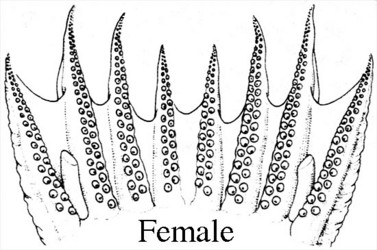
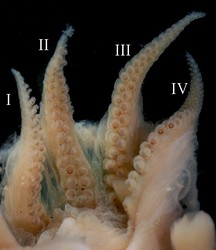
Figure. Oral view of the brachial crown of S. leucoptera. Left - Female, 14.8 mm ML, eastern South Atlantic off Nambia, Africa. Drawing from Villanueva and Sánchez (1993). Right - Female, 22 mm ML, preserved, western North Atlantic off USA. Photograph by R. Young.
- Arms not modified in females.
- Tentacles
- Tentacle organ adjacent to or barely overlapping sucker-bearing club.
- Proximal suckers large, followed by small suckers then gradually larger suckers distally.
- Funnel
- Funnel/mantle locking-apparatus with straight, simple groove in funnel component and straight, low ridge in mantle component.
 Click on an image to view larger version & data in a new window
Click on an image to view larger version & data in a new window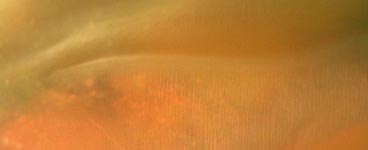
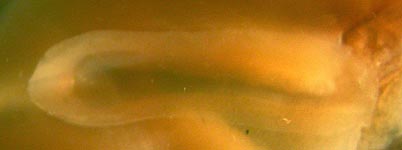
Figure. Funnel/mantle locking-apparatus of S. leucoptera, 43°02'N, 69°04'W, NMNH 816246, left side of images is anterior. Top - Side-oblique view of the mantle component. Bottom - Frontal view of the funnel component. Photographs by M. Vecchione.
- Funnel/mantle locking-apparatus with straight, simple groove in funnel component and straight, low ridge in mantle component.
- Mantle (from Villanueva and Sánchez, 1993)
- Mantle dorsally fused to head by narrow commisure.
- Ventral mantle shield length nearly equal to ventral mantle length.
- Mantle bulges dorsally.
- Anterior margin of ventral mantle slightly indented in midline.
 Click on an image to view larger version & data in a new window
Click on an image to view larger version & data in a new window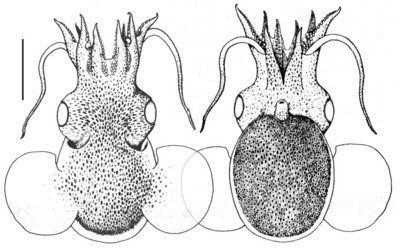
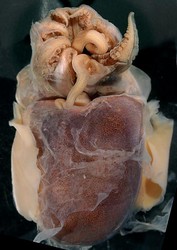
Figure. Dorsal and/or ventral views of S. leucoptera. Left - Male, 15.6 mm ML, eastern South Atlantic off Nambia, Africa. Drawing from Villanueva and Sánchez (1993). Right - Male, 19 mm ML, preserved, western North Atlantic off USA. Photograph by R. Young.
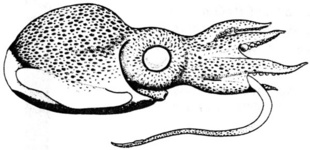
Figure. Side view of S. leucoptera, Male, 15.6 mm ML, eastern South Atlantic off Nambia, Africa, showing dorsal hump of mantle. Drawing from from Villanueva and Sánchez (1993).
- Fins
- Posterior fin lobes broadly rounded.
- Photophores
- Large, visceral photophore with pair of papillae located near midline. Internal to each papilla are two ducts that penetrate the "lens" but are invisible laterally.
- Pigmentation
- Value uncertain. At present no known specific characters are associated with pigmentation. However, we suspect this will be important in the future especially in separating closely related species such as S. maoria.
- Viscera
- Large, gelatinous masses, similar in appearance to swollen funnel organs, present in both sexes on either side of the mantle cavity between gills and funnel organ.
Comments
The above description is taken from specimens captured off NE USA and from the paper of Villaneueva and Sanchez (1993) from off Namibia.
Comparison of S. leucoptera with other Stoloteuthis species can be found on the Stoloteuthis page.
Distribution
Type locality: Gulf of Maine, 48 km east from Cape Ann, Atlantic Ocean. Known as far south along USA coast the Straits of Florida (Cairns, 1976). Also known from the N.E. Atlantic at 47°N, 5.8°W (Degner, 1925), Mediterranean Sea (Villanueva and Sánchez, 1993), and off Namibia (Villanueva and Sánchez, 1993).
References
Cairns, S. D. 1976. Biological results of the University of Miami deep-sea expeditions. 118. Cephalopods collected in the Straits of Florida by the R/V GERDA. Bull. Mar. Sci., 26: 233-272.
Degner, E. 1925. Cephalopoda. Report on the Danish Oceanographical Expeditions 1908-10 to the Mediterranean and Adjacent Seas, 2(9):1-94.
Villaneueva, R. and P. Sánchez. 1993. Cephalopods of the Benguela Current off Namibia: new additions and considerations in the genus Lycoteuthis. Journal of Natural History, 27: 15-46.
Title Illustrations

| Scientific Name | Stoloteuthis leucoptera |
|---|---|
| Location | Gulf of Maine |
| Comments | trawled in the Gulf of Maine |
| View | ventrolateral |
| Copyright | © 1996 Laurie Minor-Penland |
| Scientific Name | Stoloteuthis leucoptera |
|---|---|
| Reference | left from Verrill, A.E. 1881. The cephalopods of the north-eastern coast of America. Part II. The smaller cephalopods, including the "squids" and the octopi, with other allied forms. Trans. Connecticut Acad. Sciences, 5: 259-446; right from Vecchione, M., C. F. E. Roper and M. J. Sweeney. 1989. Marine flora and fauna of the eastern United States. Mollusca: Cephalopoda. NOAA Tech. Rep. NMFS 73: 23 pp. |
| View | ventral, dorsal |
About This Page

National Museum of Natural History, Washington, D. C. , USA

University of Hawaii, Honolulu, HI, USA
Page copyright © 2014 and
 Page: Tree of Life
Stoloteuthis leucoptera .
Authored by
Michael Vecchione and Richard E. Young.
The TEXT of this page is licensed under the
Creative Commons Attribution-NonCommercial License - Version 3.0. Note that images and other media
featured on this page are each governed by their own license, and they may or may not be available
for reuse. Click on an image or a media link to access the media data window, which provides the
relevant licensing information. For the general terms and conditions of ToL material reuse and
redistribution, please see the Tree of Life Copyright
Policies.
Page: Tree of Life
Stoloteuthis leucoptera .
Authored by
Michael Vecchione and Richard E. Young.
The TEXT of this page is licensed under the
Creative Commons Attribution-NonCommercial License - Version 3.0. Note that images and other media
featured on this page are each governed by their own license, and they may or may not be available
for reuse. Click on an image or a media link to access the media data window, which provides the
relevant licensing information. For the general terms and conditions of ToL material reuse and
redistribution, please see the Tree of Life Copyright
Policies.
- First online 26 December 2007
- Content changed 03 November 2013
Citing this page:
Vecchione, Michael and Richard E. Young. 2013. Stoloteuthis leucoptera . Version 03 November 2013. http://tolweb.org/Stoloteuthis_leucoptera/27774/2013.11.03 in The Tree of Life Web Project, http://tolweb.org/







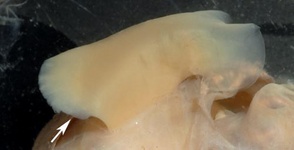

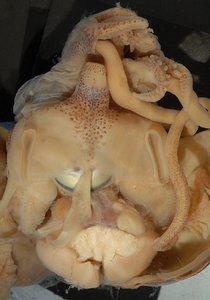
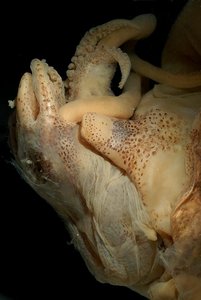
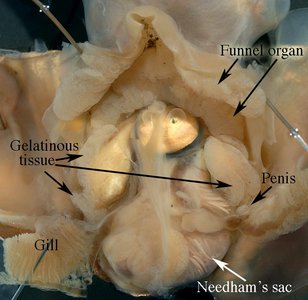
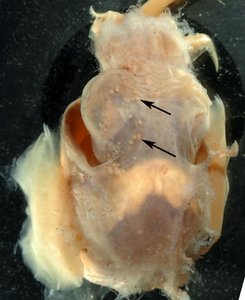




 Go to quick links
Go to quick search
Go to navigation for this section of the ToL site
Go to detailed links for the ToL site
Go to quick links
Go to quick search
Go to navigation for this section of the ToL site
Go to detailed links for the ToL site